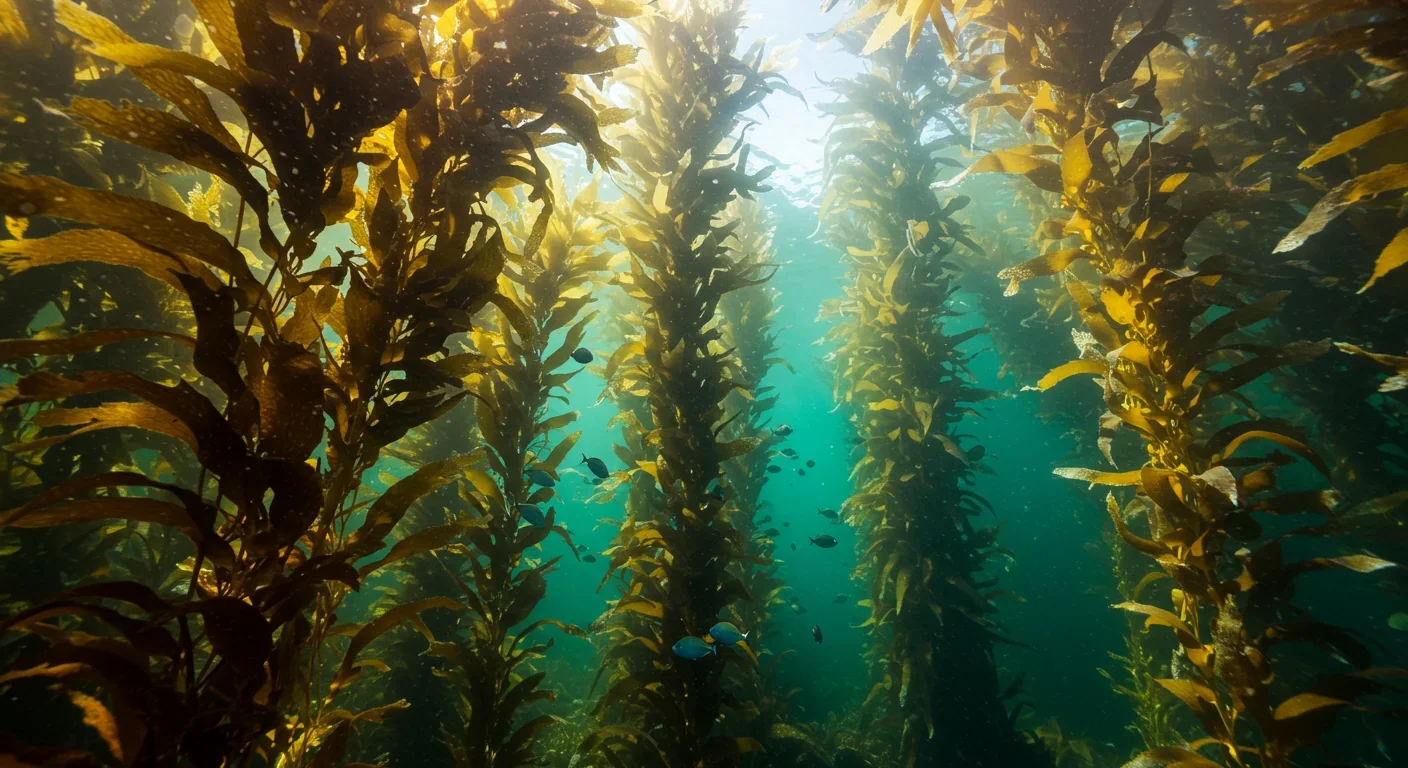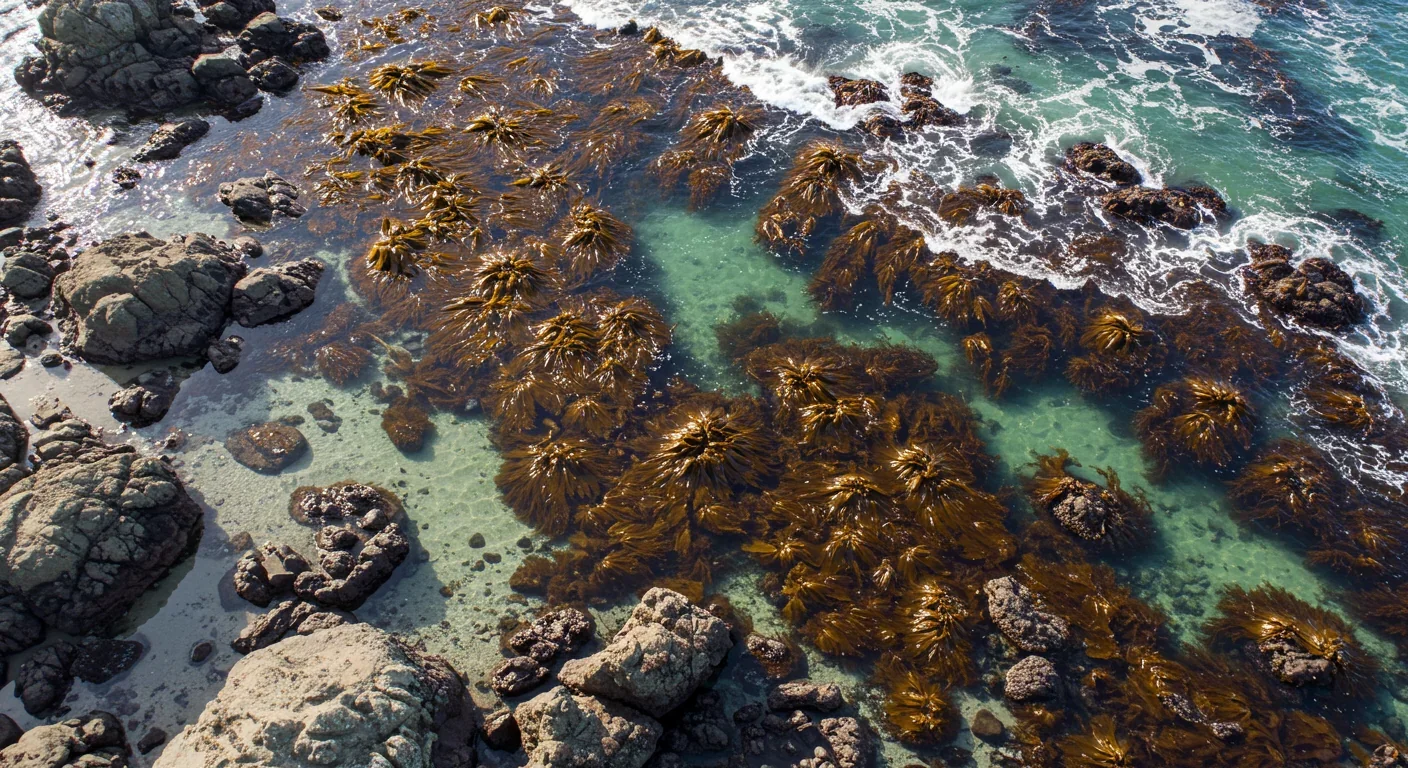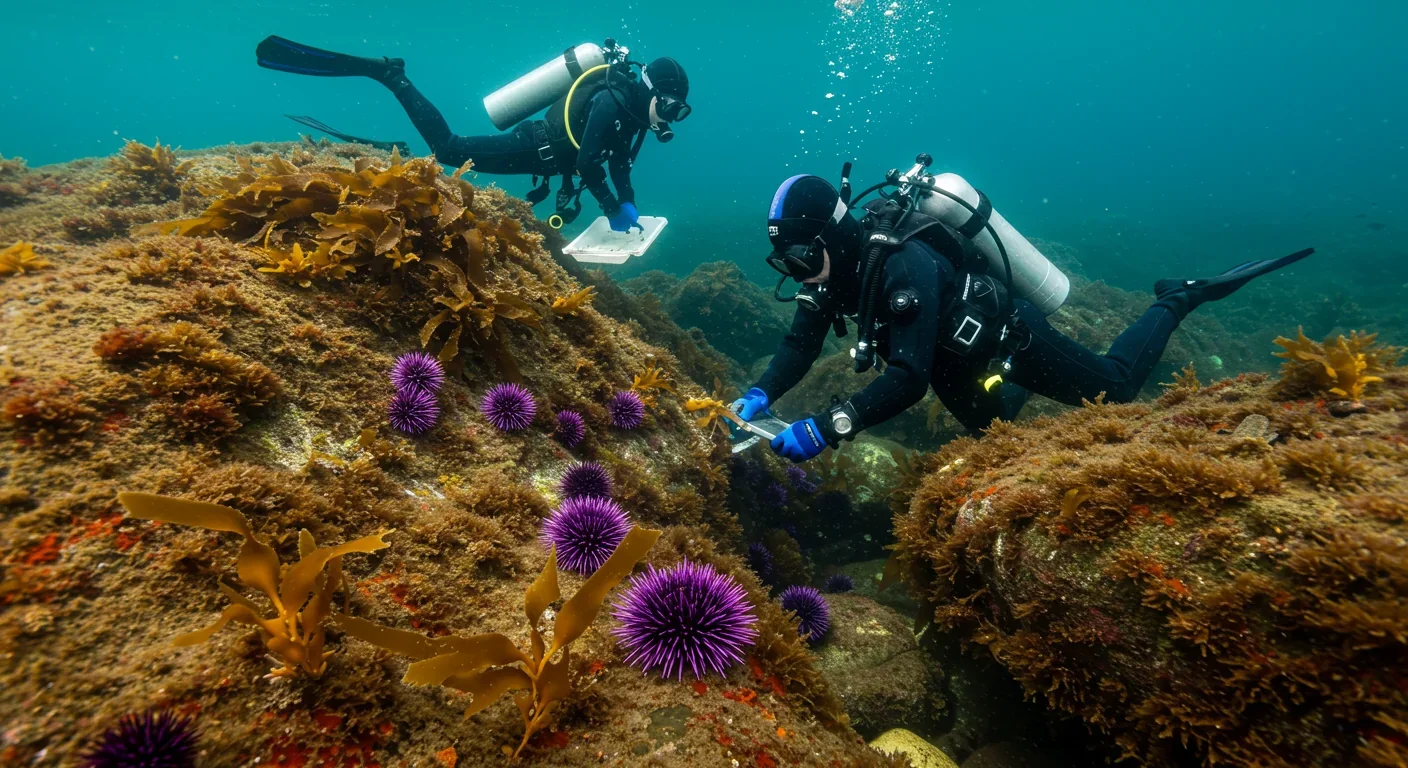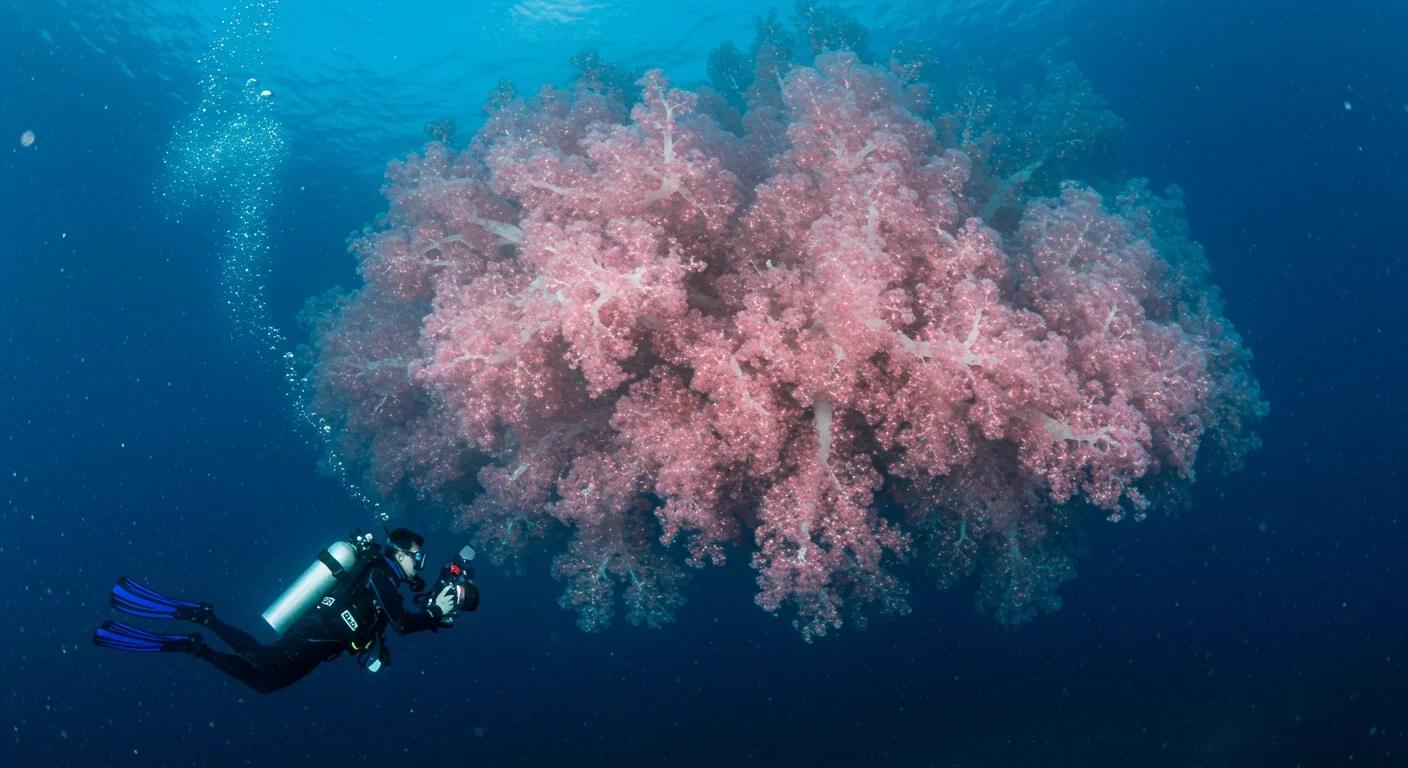Digital Pollution Tax: Can It Save Data Centers?

TL;DR: Kelp forests—Earth's fastest-growing organisms—expand and contract with tides in a twice-daily breathing rhythm driven by lunar gravity. This tidal pulse delivers nutrients, regulates growth, and shapes entire marine ecosystems. But climate change, warming oceans, and human impacts have already destroyed half the world's kelp forests, threatening critical carbon sequestration and biodiversity. New drone monitoring technology reveals exactly how tides orchestrate kelp dynamics, while restoration projects demonstrate that strategic urchin removal can revive even devastated forests—if we act before tipping points are crossed. Understanding this hidden pulse isn't just marine biology; it's essential for predicting which underwater forests will survive the turbulent century ahead.

Beneath the surface of the Pacific Ocean, a 45-meter-tall organism stretches toward sunlight, growing up to 60 centimeters in a single day—faster than bamboo, faster than any plant on land. This is giant kelp, and it doesn't just grow in the ocean. It breathes with it. Every six hours, as tides rise and fall, these underwater forests expand and contract in a rhythmic dance that has shaped marine ecosystems for millions of years. Now, as climate change threatens to disrupt these ancient rhythms, scientists are racing to understand the invisible pulse that keeps kelp forests alive—and what happens when that pulse begins to falter.
The stakes couldn't be higher. Over the past 50 years, more than half of the world's kelp forests have vanished. Marine heatwaves in the 2010s obliterated 95% of Northern California's kelp ecosystems. Yet these underwater forests sequester up to 2.8 teragrams of carbon annually—roughly a third of Australia's entire blue carbon budget—while providing habitat for thousands of species and food for millions of people. Understanding how tides drive kelp forest dynamics isn't just an academic exercise. It's becoming essential to predicting which forests will survive the coming century and which will disappear beneath warming waves.
Long before humans walked upright, kelp and tides formed a partnership written in the physics of gravity and the chemistry of seawater. The same differential gravitational forces that create Earth's tidal bulges—with lunar forces about twice as strong as solar ones—also determine where kelp can thrive and how fast it grows.
This relationship operates on multiple timescales simultaneously. Twice daily, tides flood kelp forests with nutrient-rich seawater, delivering the nitrogen and phosphorus that fuel their extraordinary growth rates. During high tide, kelp fronds float near the surface, maximizing photosynthesis. During low tide, the same fronds may be exposed to air or compressed beneath the waves, creating stress that paradoxically strengthens the organism.
The kelp species Nereocystis luetkeana—bull kelp—exemplifies this tidal dependence. Growing to 36 meters tall with a single gas-filled float containing carbon monoxide, it thrives exclusively in high-current, semi-exposed habitats where tidal flows are strongest. Research by Britton-Simmons and colleagues demonstrated that tidal current strength directly correlates with bed size and density. Remove the tidal currents, and Nereocystis simply cannot survive. The water movement prevents sediment from smothering microscopic gametophytes during reproduction, ensures adequate light penetration, and delivers the nutrients that enable blade growth rates of 15 centimeters per day—roughly the height of a smartphone added to each frond every 24 hours.
But the most dramatic tidal effects reveal themselves at the forest scale. Using high-resolution drone imagery across full tidal cycles, researchers discovered that a single meter of tidal rise can reduce visible kelp canopy by 15% in some locations and over 30% in others. The kelp isn't shrinking—it's being pulled underwater as buoyancy fails to compensate for the increased water column above. This twice-daily compression and expansion creates a breathing motion visible from space, a planetary-scale respiration driven by lunar gravity.
Inside a kelp frond, tidal rhythms orchestrate a complex metabolic symphony. The organism has evolved multiple mechanisms to capitalize on tidal cycles, turning gravitational physics into biological advantage.
Nutrient uptake provides the clearest example. Kelp can translocate nutrients along its stipe—the stem-like structure connecting holdfast to blades—at speeds reaching 60 centimeters per hour. This internal transport system, built from sieve elements similar to those in land plants, allows kelp to move resources from nutrient-rich depths to photosynthetically active surface tissues. During tidal flushing, when currents deliver pulses of nitrogen and phosphorus, uptake rates spike. The timing matters: research shows that nutrient delivery patterns change dramatically with tidal regime, with the most productive kelp forests located where tidal currents reliably deliver upwelled, nutrient-dense water.
The structural adaptations are equally sophisticated. Kelp must simultaneously maximize surface area for light capture while minimizing drag from tidal currents that can exceed several knots. The solution involves extraordinary material properties—kelp tissue combines tensile strength comparable to synthetic fibers with flexibility that allows fronds to stream with currents rather than resist them. High-profile organisms like kelp, as intertidal ecology research demonstrates, avoid breaking in high-flow locations through this combination of strength and flexibility.
Even reproduction synchronizes with tides. Nereocystis, uniquely among kelp species, drops entire spore-bearing patches (sori) that settle adjacent to the parent holdfast, ensuring genetic material lands in proven habitat. This only works because tidal currents are predictable—the spores can "trust" that local hydrodynamics will place them appropriately. In areas with irregular or weak tidal flows, this reproductive strategy fails, and Nereocystis disappears.
The most counterintuitive adaptation involves stress tolerance. Kelp in areas with extreme tidal range—where low tides may expose fronds to air and UV radiation—develop greater stress resistance than their constantly submerged cousins. This intertidal exposure, seemingly disadvantageous, acts as a form of environmental training that produces more resilient organisms. The challenge lies in distinguishing beneficial stress from damaging stress, a distinction that climate change is rapidly blurring.

The abstract physics of tidal forcing becomes visceral reality along the Pacific coast of North America, where kelp forests face an unprecedented combination of stressors that interact with tidal dynamics in complex ways.
Northern California: The 95% Solution
Between 2014 and 2016, Northern California experienced a perfect storm of ecological disruption. Marine heatwaves elevated water temperatures beyond kelp's thermal tolerance. Sea star wasting disease decimated sunflower stars, keystone predators of purple sea urchins. With predation pressure removed, urchin populations exploded, creating vast "urchin barrens"—seafloor deserts where kelp cannot establish. The result: a 95% loss of kelp ecosystems across hundreds of kilometers of coastline.
Tidal dynamics played a contradictory role in this collapse. Areas with strong tidal currents initially showed resilience—the currents delivered cooler water and prevented the most extreme temperature spikes. But once urchin populations reached critical density, even strong tidal flows couldn't save kelp forests. Urchins consumed new growth faster than tides could deliver nutrients to replace it.
Reef Check's restoration efforts at Tankers Reef and Big Sur illustrate both the problem and potential solutions. In October 2022, commercial divers removed approximately 6,000 pounds of urchins from a 2.5-acre site at Big Sur. Within months, kelp began regrowing. By 2023, with urchin densities kept low through continued culling, kelp coverage expanded dramatically. The lesson: tidal-driven nutrient delivery can support rapid kelp recovery, but only if herbivore pressure is controlled first. Tides provide the raw materials for growth, but ecological balance determines whether that growth can occur.
Santa Barbara and Palos Verdes: The Canopy Compression Effect
Frontiers in Environmental Science research using drone surveys across full tidal cycles revealed striking differences in kelp's tidal response at different locations. At Arroyo Quemado near Santa Barbara, a one-meter tidal rise reduced floating canopy by approximately 15%. At Honeymoon Cove in Palos Verdes, the same tidal increase cut canopy by over 30%.
What explains this geographic variation? Bathymetry and reef orientation. Palos Verdes kelp grows on reefs with steeper drop-offs, meaning a modest tidal rise significantly increases the water column above the canopy. Santa Barbara's gentler slopes allow kelp to maintain more canopy exposure even as tides rise. This seemingly technical distinction has profound implications: it means kelp forests' vulnerability to sea level rise—and the changing tidal dynamics sea level rise entails—depends critically on local seafloor topography.
The research employed a novel vegetation index (Normalized Difference Red-Edge Blue, or NDREB) achieving 93% accuracy in distinguishing kelp from water in drone imagery. This technological breakthrough enables monitoring at spatial (10 cm per pixel) and temporal (sub-daily) resolutions impossible with satellites, revealing tidal dynamics previously hidden from science. The kelp, it turns out, has always been breathing with the tides. We've only recently developed eyes precise enough to watch.
Chile and the Southern Hemisphere: A Different Tidal Regime
While Pacific coast North American kelp forests face warming waters and ecological disruption, Southern Hemisphere kelp forests—particularly along Chile's extensive coastline—experience different tidal patterns and different threats. Chilean kelp forests inhabit a complex tidal environment influenced by the Humboldt Current, which delivers cold, nutrient-rich water year-round but creates tidal patterns distinct from North Pacific systems.
The key difference involves upwelling intensity and timing. Chilean kelp forests depend on wind-driven upwelling that peaks during spring and summer, delivering nutrients that coincide with maximal growth periods. Tidal currents modulate this upwelling, creating localized zones of enhanced productivity. Research indicates Chilean kelp forests sequester significant carbon—contributing substantially to regional blue carbon budgets—but face mounting pressure from artisanal harvesting and salmon farming operations that alter coastal nutrient dynamics.
The contrast with North American systems illuminates a broader principle: tidal forcing operates universally, but local context determines outcomes. Understanding kelp forests requires understanding not just tides in general, but the specific tidal regime, coastal topography, and ecological community at each location.
For millions of years, kelp forests and tides coevolved in relative stability. Over the past century, human activities have disrupted this relationship with accelerating intensity.
Coastal Development and Altered Hydrodynamics
Ports, marinas, and coastal armoring fundamentally alter tidal flow patterns. Breakwaters reduce current speeds and change water circulation, often decreasing nutrient delivery to kelp forests. Dredging operations suspend sediments that block light penetration. Even seemingly minor coastal modifications can shift local tidal dynamics enough to stress kelp populations already near their physiological limits.
The Pacific coast of North America has lost significant kelp forest area to direct habitat destruction, but the more insidious threat comes from cumulative alterations to coastal hydrodynamics. A kelp forest may persist adjacent to a marina for years or decades, slowly declining as altered tidal flows reduce nutrient delivery or increase sedimentation, until a marine heatwave or other acute stressor delivers the final blow.
Pollution and Nutrient Dynamics
Agricultural runoff and sewage discharge add nitrogen and phosphorus to coastal waters—theoretically beneficial for kelp, which requires these nutrients. In practice, pollution-sourced nutrients often promote harmful algal blooms and bacterial growth that block light or create hypoxic conditions. The nutrients arrive in wrong quantities, wrong ratios, and wrong chemical forms compared to the natural tidal delivery kelp forests evolved to utilize.
Additionally, pollutants like heavy metals and persistent organic compounds accumulate in kelp tissue, potentially impairing physiological processes including nutrient uptake and stress response. Tidal flushing, which historically cleared temporary contamination, cannot compensate for chronic pollution loads.
Climate Change: The Metronome Speeds Up
Global heating affects kelp forests through multiple pathways that interact with tidal dynamics in complex ways:
Temperature: Marine heatwaves push kelp beyond thermal tolerance limits. Tidal currents that historically delivered cooling water during low-tide exposure now sometimes bring anomalously warm water, transforming a protective mechanism into a threat.
Sea Level Rise: As seas rise, tidal ranges and patterns shift. Kelp forests adapted to current tidal regimes may find themselves in subtidal zones with reduced tidal variation, decreasing nutrient delivery and growth rates. Conversely, some kelp may experience greater tidal exposure, increasing desiccation stress.
Ocean Acidification: Increasing atmospheric CO₂ acidifies seawater, potentially impairing kelp's ability to uptake dissolved inorganic carbon for photosynthesis. The interaction between tidal nutrient delivery and carbonate chemistry remains poorly understood but potentially critical.
Changing Upwelling: Climate models predict shifts in wind patterns that drive coastal upwelling, potentially decoupling the seasonal nutrient delivery that kelp forests depend on from the tidal cycles that distribute those nutrients.
The most concerning possibility involves threshold effects and tipping points. Kelp forests may tolerate multiple stressors individually but collapse when stressors combine and interact. A kelp forest might survive temperature stress, or reduced tidal flushing, or moderate herbivory—but not all three simultaneously.
As kelp forests decline globally, conservation efforts are increasingly incorporating tidal dynamics into protection and restoration strategies.
The Kelp Forest Alliance: Standardizing Monitoring
In 2024, Ocean Wise and the Kelp Forest Alliance released Monitoring Kelp Forest Ecosystems: A Guidebook to Quantifying Biodiversity, Ecosystem Health, and Ecosystem Benefits—the most comprehensive standardized protocol for kelp forest monitoring to date. The guidebook's significance lies in creating a common language for restoration projects across 13 countries, enabling comparison of restoration outcomes and identification of best practices.
Crucially, the guidebook incorporates tidal stage as a key variable in monitoring protocols. By standardizing the tidal heights at which surveys occur, researchers can distinguish real ecological changes from tidal artifacts. This addresses a longstanding problem: historical kelp forest surveys often failed to record tidal conditions, making temporal comparisons unreliable.
The Alliance's goal—protecting 4 million hectares of kelp forests by 2040—requires not just good intentions but rigorous data demonstrating which interventions work. As Carlos Drews, Executive Vice President of Conservation at Ocean Wise, noted: "Over 50% of kelp forests have declined in the past 50 years due to climate change and ecosystem imbalances." Without standardized monitoring that accounts for tidal variation, measuring progress toward restoration goals remains impossible.
Marine Protected Areas: Protecting Tidal Function
Marine protected areas (MPAs) offer a powerful tool for kelp forest conservation when properly designed. Effective kelp forest MPAs protect not just the kelp itself but the ecological interactions and physical processes—including tidal dynamics—that kelp depends on.
Key design principles include:
Adequate size: MPAs must encompass enough area to capture natural tidal variation and the full suite of species kelp forests support.
Connectivity: MPAs should protect dispersal corridors allowing kelp spores and associated species to move with tidal currents.
Ecosystem-based management: Protecting kelp requires protecting predators that control herbivores, maintaining trophic balance that allows kelp to capitalize on tidal nutrient delivery.
Research demonstrates MPA effectiveness: well-designed reserves show higher kelp density, greater species diversity, and increased resilience to disturbances compared to unprotected areas. The mechanism involves restoring ecological balance—particularly predator populations—that allows kelp forests to respond naturally to tidal cycles.
Active Restoration: The Urchin Removal Strategy
Where ecological imbalances have progressed to urchin barrens, passive protection proves insufficient. Active restoration through urchin removal has emerged as the most promising intervention for degraded kelp forests.
Reef Check's multi-site efforts in Northern California illustrate both the potential and challenges:
Big Sur: Partnership with commercial urchin divers achieved rapid herbivore reduction (6,000 pounds removed in October 2022), followed by natural kelp recovery within months.
Tankers Reef: California Fish and Game Commission amendment allowing unlimited recreational urchin harvest, combined with systematic monitoring by multiple agencies, created a successful community-based restoration model.
Noyo Bay and Albion Cove: Fifteen months of restoration at Noyo Bay and four months at Albion Cove demonstrated that early intervention—before urchin barrens become entrenched—significantly improves restoration success.
The tidal connection becomes clear in restoration outcomes: once urchin pressure decreases below a threshold, the same tidal nutrient delivery that previously supported urchin populations instead fuels rapid kelp regrowth. Tides haven't changed—the ecological context has been restored to allow kelp to utilize tidal resources.
Critically, urchin removal must be sustained. Without ongoing management or restored predator populations, urchins recolonize and consume recovering kelp. This reality underscores a broader principle: working with tidal rhythms means understanding that kelp forests are dynamic systems requiring ongoing ecological processes, not static monuments to be preserved.

Emerging Technologies: Precision Monitoring
Drone-based monitoring using vegetation indices like NDREB represents a paradigm shift in kelp forest science. The ability to map canopy area at 10-centimeter resolution multiple times per day enables:
Tidal response characterization: Quantifying exactly how individual kelp forests respond to tidal cycles, identifying locations most vulnerable to sea level rise.
Growth rate estimation: Repeated surveys at consistent tidal stages reveal growth dynamics previously requiring destructive sampling.
Restoration evaluation: High-resolution monitoring documents restoration outcomes with unprecedented precision, accelerating learning about which interventions work.
Early warning systems: Detecting canopy decline before forests collapse entirely, enabling timely intervention.
As these technologies become more accessible and automated, they promise to transform kelp forest conservation from reactive crisis management to proactive adaptive management that works with, rather than against, tidal rhythms.
The relationship between tides and kelp forests illuminates principles relevant far beyond marine ecology.
Prediction in a Changing Climate
As climate change accelerates, predictive models become increasingly essential for conservation planning. Models that ignore tidal dynamics will systematically mispredict kelp forest responses to warming, sea level rise, and changing ocean chemistry.
For example, a model might predict that temperature increase of 2°C makes a location unsuitable for kelp. But if strong tidal currents deliver periodic cooling water, the forest might persist. Conversely, a location that appears thermally suitable might lack sufficient tidal flushing to deliver nutrients, preventing kelp establishment.
Incorporating tidal dynamics into predictive models requires high-resolution hydrodynamic simulations coupled with biological process models—computationally intensive but increasingly feasible with modern computing. The payoff includes identifying kelp forest refugia likely to persist through the coming century and potential restoration sites where interventions have highest probability of success.
Blue Carbon and Climate Mitigation
Kelp forests sequester substantial carbon—Australian kelp alone captures 1.3-2.8 teragrams annually, representing 27-34% of the regional blue carbon budget. Unlike terrestrial forests where carbon accumulates in long-lived trees, kelp carbon enters marine food webs or settles to deep seafloors, potentially sequestering carbon for centuries to millennia.
Tidal dynamics influence blue carbon dynamics in multiple ways:
Export efficiency: Tidal currents transport detached kelp fragments offshore, where they may sink to deep water. Stronger tidal flows generally increase export.
Decomposition rates: Tidal flushing delivers oxygen that affects decomposition of kelp detritus. Optimal tidal flows maximize both growth (carbon uptake) and export (carbon sequestration).
Ecosystem productivity: Nutrient delivery via tidal currents determines overall forest productivity and thus carbon fixation rates.
If kelp forest conservation and restoration becomes a significant climate change mitigation strategy—increasingly plausible given their high productivity and carbon export—understanding and managing tidal dynamics will be essential for maximizing blue carbon sequestration.
Lessons for Human Systems
The kelp-tide relationship offers metaphorical insights for human societies navigating technological and environmental change:
Work with natural rhythms: Kelp doesn't resist tides—it evolved to capitalize on them. Sustainable human systems similarly should work with rather than against natural cycles.
Context matters: Universal tidal forces produce locally specific outcomes depending on bathymetry, ecology, and history. Effective solutions require understanding local context, not just general principles.
Thresholds and tipping points: Kelp forests tolerate considerable environmental variation until cumulative stressors trigger rapid collapse. Human systems show similar dynamics—gradual stress accumulation followed by sudden systemic failure.
The value of monitoring: High-resolution drone monitoring revealed tidal dynamics invisible to coarser observation methods. Better measurement enables better management—true for ecosystems and human institutions alike.
Stand on the California coast at low tide, looking out over exposed reef and kelp fronds draped across rocks, and you're witnessing a scene that has repeated twice daily for millions of years. In six hours, those same rocks will be submerged beneath meters of water, kelp canopies floating at the surface, nutrient-rich currents flowing through the forest. This is the hidden pulse—the tidal heartbeat that has sustained underwater forests since before humanity existed.
But that pulse is becoming irregular. Climate change is altering sea levels, temperature patterns, and ocean chemistry in ways that interact with tidal dynamics in complex, sometimes unpredictable ways. Human impacts have disrupted the ecological balance that allows kelp to capitalize on tidal rhythms. Half the world's kelp forests have already vanished.
Yet the story isn't only decline. Understanding the kelp-tide relationship opens new possibilities for conservation and restoration. By working with tidal rhythms rather than ignoring them—through strategic MPA placement, urchin removal timed to maximize kelp regrowth, monitoring protocols that account for tidal variation—we can help kelp forests persist through the turbulent century ahead.
The Kelp Forest Alliance aims to protect 4 million hectares by 2040. Reef Check's restoration projects demonstrate that even 95% loss isn't necessarily permanent—remove the urchins, and kelp can rebound in months, provided tidal conditions remain suitable. Drone monitoring technology enables precise tracking of restoration outcomes at scales previously impossible.
Whether these efforts succeed depends partly on science and management, partly on political will and funding, but fundamentally on whether we can expand our temporal perspective. Kelp forests operate on tidal timescales—twice daily, lunar monthly, seasonal, interannual. Human institutions typically operate on quarterly earnings reports and election cycles. Aligning these mismatched timescales represents one of the central challenges of ocean conservation.
The kelp forests of 2050 will be different from those of 1950 or 2000. The question isn't whether they'll change—that's guaranteed—but whether they'll persist at all, and in what form. Will Pacific coasts still feature towering forests of Macrocystis and Nereocystis, pulsing with tidal rhythms, sheltering thousands of species and sequestering gigatons of carbon? Or will warming water and ecological collapse reduce them to scattered remnants in a few protected refugia, relics of a cooler ocean?
The answer depends on choices being made now—not just by policymakers and scientists, but by everyone who affects coastal ecosystems through consumption patterns, political engagement, and resource use. The tides will continue their gravitational dance regardless of human action. Whether kelp forests continue dancing with them is up to us.
As you contemplate underwater forests breathing with lunar rhythms, consider: we are living through the brief historical window when human action can still determine the outcome. The forests have survived ice ages and warming periods before, but never previously faced anthropogenic climate change and ecosystem disruption. They need the same partnership with humanity that they've maintained with tides for millions of years—a relationship where both parties benefit, neither dominates, and the rhythm continues across generations.
The hidden pulse of ocean ecosystems still beats. For now.

Over 80% of nearby white dwarfs show chemical fingerprints of destroyed planets in their atmospheres—cosmic crime scenes where astronomers perform planetary autopsies using spectroscopy. JWST recently discovered 12 debris disks with unprecedented diversity, from glassy silica dust to hidden planetary graveyards invisible to previous surveys. These stellar remnants offer the only direct measurement of exoplanet interiors, revealing Earth-like rocky worlds, Mercury-like metal-rich cores, and ev...

Hidden mold in homes releases invisible mycotoxins—toxic chemicals that persist long after mold removal, triggering chronic fatigue, brain fog, immune dysfunction, and neurological damage. Up to 50% of buildings harbor mold, yet most mycotoxin exposure goes undetected. Cutting-edge airborne testing, professional remediation, and medical detox protocols can reveal and reverse this silent epidemic, empowering individuals to reclaim their health.

Data centers consumed 415 terawatt-hours of electricity in 2024 and will nearly double that by 2030, driven by AI's insatiable energy appetite. Despite tech giants' renewable pledges, actual emissions are up to 662% higher than reported due to accounting loopholes. A digital pollution tax—similar to Europe's carbon border tariff—could finally force the industry to invest in efficiency technologies like liquid cooling, waste heat recovery, and time-matched renewable power, transforming volunta...

Transactive memory is the invisible system that makes couples, teams, and families smarter together than apart. Psychologist Daniel Wegner discovered in 1985 that our brains delegate knowledge to trusted partners, creating shared memory networks that reduce cognitive load by up to 40%. But these systems are fragile—breaking down when members leave, technology overwhelms, or communication fails. As AI and remote work reshape collaboration, understanding how to intentionally build and maintain ...

Mass coral spawning synchronization is one of nature's most precisely timed events, but climate change threatens to disrupt it. Scientists are responding with selective breeding, controlled laboratory spawning, and automated monitoring to preserve reef ecosystems.

Your smartphone isn't just a tool—it's part of your mind. The extended mind thesis argues that cognition extends beyond your skull into devices, AI assistants, and wearables that store, process, and predict your thoughts. While 79% of Americans now depend on digital devices for memory, this isn't amnesia—it's cognitive evolution. The challenge is designing tools that enhance thinking without hijacking attention or eroding autonomy. From brain-computer interfaces to AI tutors, the future of co...

Transformers revolutionized AI by replacing sequential processing with parallel attention mechanisms. This breakthrough enabled models like GPT and BERT to understand context more deeply while training faster, fundamentally reshaping every domain from language to vision to multimodal AI.